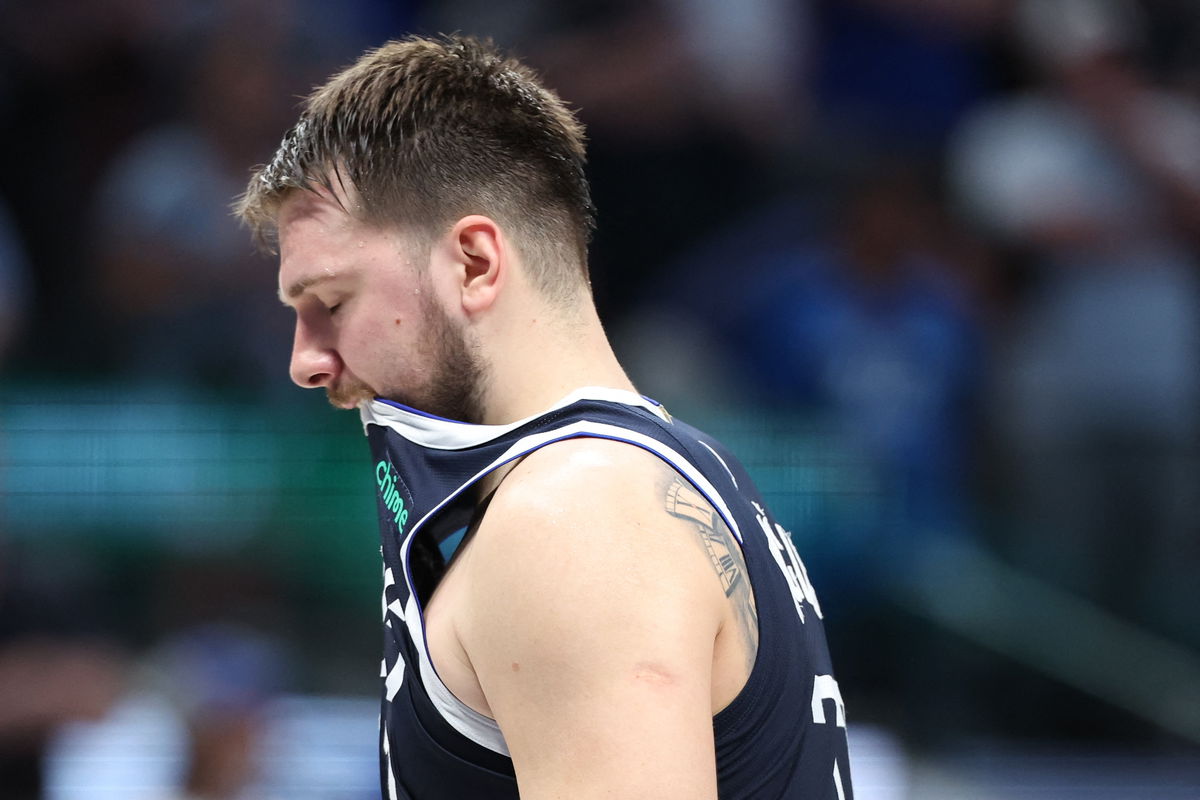
USA Today via Reuters
May 28, 2024; Dallas, Texas, USA; Dallas Mavericks guard Luka Doncic (77) reacts during the fourth quarter of game four against the Minnesota Timberwolves in the western conference finals for the 2024 NBA playoffs at American Airlines Center. Mandatory Credit: Kevin Jairaj-USA TODAY Sports

USA Today via Reuters
May 28, 2024; Dallas, Texas, USA; Dallas Mavericks guard Luka Doncic (77) reacts during the fourth quarter of game four against the Minnesota Timberwolves in the western conference finals for the 2024 NBA playoffs at American Airlines Center. Mandatory Credit: Kevin Jairaj-USA TODAY Sports
From Pokemon cards to THE most coveted RPA card, some people are just inherently lucky! Sports collectibles fetch a pretty penny, no doubt. But it’s so much more than that. Collectors buy these game-used items (which have seen exponential growth of late), purely for the joy of owning them rather than the profitable side of it. Of course, they can turn out to be lifesavers if you ever find yourself in a hard place financially. But collectors, as mentioned, primarily buy them because of the nostalgia and emotional bond associated with a player or a team.
Watch What’s Trending Now!
But Grant Williams might be open to exploring the market before deciding on holding or selling. Yes, the first-time basketball cards collector was at Fanatics Fest in New York, and to his surprise he stumbled upon a rare Luka RPA! Let’s hear the experience from Doncic’s former teammate himself.
ADVERTISEMENT
Grant Williams narrates his first time as a collector and landing the rare Luka Doncic RPA
“I’ve been collecting Pokemon cards, but today is my first day collecting basketball cards,” the 25-year-old shared with barely-concealed excitement to Darren Rovell of Cllt media. Williams bought the 2018-19 Panini National Treasures box for $10,500 to test his luck. Given that Luka Doncic RPA is worth at least $100,000, it’s money well spent. And his reaction to pulling the unbelievable says a lot.
“I screamed, because when I first bought it, I said, ‘So, what can I do to get my money back?’ And they’re like, ‘Probably get a Trae (Young) or something like that.’ That gets me like 10 grand. So, when I am opening, I get past it, and I’m like, I got a Nate “Tiny” Archibald, I get something else, and then I see a blue streak and I’m like Luka Doncic. And I see nine out of ten. And I just run.”
Top Stories
Kyrie Irving Breaks Silence After Injury Return Update Emerges

Prayers Pour In For Napheesa Collier After Unfortunate Health Announcement

Is Austin Reaves Dating YouTuber SteveWillDoIt’s Ex-Girlfriend? Fact Checking Viral Claim

Stephen Curry, Warriors Bench Furiously Protest Against Shai Gilgeous-Alexander After NBA Refs’ Blunder

Michael Jordan Could Have Repaired Scottie Pippen Relationship if He Wanted To: Former Teammate

Hornets forward @Grant2Will, on his first day collecting basketball cards, bought a box of National Treasures for $10,500.
He pulled a Luka Dončić worth at least $100,000. pic.twitter.com/ZOJANbK9sg
— Darren Rovell (@darrenrovell) August 16, 2024
ADVERTISEMENT
Talk about beginner’s luck. Watching Grant swipe the exquisite card, many immediately approached him, even before the item was graded, offering $250,000 to $500,000 for the Luka RPA. But it seems like Williams had other ideas. For one, he planned to get it to PSA (Professional Sports Authenticator) to get the collectible authenticated and graded. And the next was to give the Slovenian superstar a chance to buy it from him.
“I’ve got to give Luka the first right to refusal, just because he would buy this for like a million, I bet,” he said. “So, that’s why I was like ‘Let me make sure I call Luka.’ I FaceTimed him twice, he didn’t pick up. He’s in Slovenia right now. So he’ll call me back and I got to talk to him about it because this is absurd.”
ADVERTISEMENT
Reposting the video on his X account, Williams captioned it: “Offered 300k on the spot. Gotta give my brother LD a chance first tho,” followed by a handshake and fire emoji.
Offered 300k on the spot. Gotta give my brother LD a chance first tho 🤝🔥 https://t.co/wQcJXhDaKK
— Grant Williams (@Grant2Will) August 16, 2024
Well, kudos to the entrepreneurial side of Grant Williams. But since we have yet to hear or see the 5x All-Star come out of his collector closet, the Hornets forward might be better off holding on to the RPA. As for the highest a Luka RC has sold for happened in November 2022. An extremely rare 2018 National Treasures Luka Doncic Rookie NBA Logoman Patch card was sold for $3.12 million, the highest to have been sold at a public auction!
ADVERTISEMENT
While the acronyms mentioned here might make sense for a collector, they can be confusing for others. So, let’s take a quick look at what they mean.
What is an RPA?
A Rookie Patch Autograph card or RPA is exactly what it says – a rookie card that holds both the autograph and a “patch” or a piece of the rookie jersey. And in this case, the RPA card belonged to the Dallas Mavericks’ superstar, Luka Doncic. There was much concern among the Mavs fans as to how the international phenom would fit into Dallas. Well, we can safely say that ‘Luka Wizardry’ has taken the ‘Lone Star State’ places, in addition to bagging one of the finest ball-handlers in the NBA, Kyrie Irving.
ADVERTISEMENT
Now, how about the PSA? Sure, you saw what it stands for. But why exactly did Grant Williams say that he had to take it there for grading?
What is PSA?
Launched in 1991, the Professional Sports Authenticator is one of the most reputable third-party sports memorabilia authentication and grading authorities. Headquartered in Southern California, the PSA has offices in China and Japan as well. According to their official website, they have certified over 65 million items to date.
ADVERTISEMENT
As for their grading system, it’s no joke. While the cards are graded on a simple 1-10 scale, the thorough checking of the details is what makes or breaks the value of a card. Obviously, 10 is the highest grade, the perfect card. But even then, depending on the circumstances and the age of the card, they might allow a few exceptions. The numerical grading is based on four categories.
- Centering: Centering is of paramount importance if the collector plans to sell them in the future. When a card is examined for centering, it’s divided into left/right and top/bottom to check what percentage is off-centered. A perfectly centered card is measured as 50/50, meaning that 50% of the card is on the left/right and 50% is top/bottom. Per PSA guidelines, the image must be centered between 55/45 to 60/40 on the front and 70/30 on the reverse.
- Corners: With time, corners can get frayed. It’s inevitable. But for a PSA grade of 10, the corners have to be perfect. And of course, what might look like a perfect corner to us, need not be the case for PSA card graders. They use various methods to ensure the cards are in pristine condition.
- Edges: Similar to the corners, the edges also have to be of good quality. Unlike invisible fraying on the corners, the slight problems on the edges can very well be seen by the naked eye. A chipped edge on a card will expose the white borders on the card. Hence, perfection on the outside and virtually no scratch under magnification.
- Surface: The immediate eye-catching aspect is definitely the surface. Cards maintained extremely well will have only a minimal (very minimal) amount of surface deterioration like the lack of glossiness, wax stains, or scratching. But as seen in the above cases, a PSA 10 grade requires, again, perfection.
Apart from the numerical grades, PSA also has three other grades – Half Point, No Authentic, and Altered Authentic.
ADVERTISEMENT
A half point means that a card, when assigning a grade of PSA 2 to 9, might get half a point increase based on certain high-end qualities (based on discretion). No Authentic refers to the fact that PSA is only labeling the card as authentic without a numerical grade. It can be for many reasons, like the existence of an alteration, or major defect, or for whatever reason, the original holder might have asked the organization to simply authenticate the item.
As for Altered Authentic, the card, due to evidence of “trimming, recoloring, restoration, and/or cleaning”, the card just cannot be graded. The collectible, is of course, genuine, but that’s all it is.
Well, there you go. What would you do if you found a rare collectible when clearing out your garage or the attic? Tell us (or show us @es_sportsnews on X) your reaction below.
ADVERTISEMENT
ADVERTISEMENT
ADVERTISEMENT
ADVERTISEMENT

